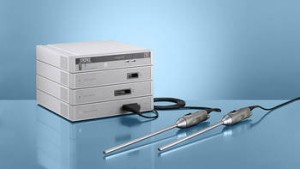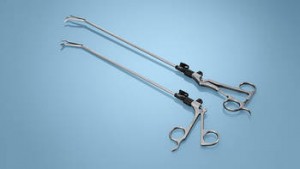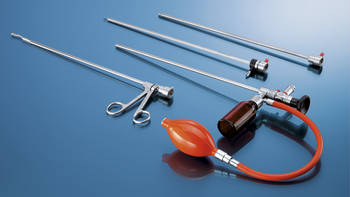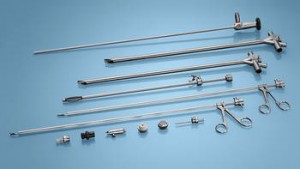Diagnosis and therapy in the thoracic region would be inconceivable without endoscopy today. Originally only used for diagnosing pleural disorders, the endoscope is now an integral component, even in major surgical procedures. Taking advantage of autofluorescence, bronchoscopy is useful for the early detection of lung tumors. Distending mediastinoscopes are used to perform extensive lymph node dissection with therapeutic intent.
The range of products available from KARL STORZ for thoracic endoscopy comprises endoscopes and instruments for endoscopic or endoscopically assisted thoracic surgery, medical thoracoscopy, mediastinoscopy as well as rigid and flexible bronchoscopy, including procedures performed with fluorescence imaging.
“This webpage content is intended for Healthcare Professional only, not for general public”

Please visit www.karlstorz.com for more information.
IMAGE1 S 3D – A Dimension Ahead
The IMAGE1 S 3D camera platform provides surgeons with excellent depth perception. Furthermore, the 3D stereoscopic imaging system is particularly valuable for activities that demand a high degree of spatial perception. Thanks to the modular system design, existing 2D systems can be upgraded to 3D.
- 3D system featuring video endoscopes with a diameter of 10 mm
- Easy toggle between 3D and 2D
- Easy integration into the IMAGE1 S platform
- Three innovative visualization technologies for easy tissue differentiation in 2D and 3D:
– CLARA: Homogeneous illumination
– CHROMA: Contrast enhancement
– SPECTRA*: Spectral color shift and switch
EndoCAMeleon® HOPKINS® Telescope
Adjustable in Every Aspect
The variable direction of view 0° – 120° allows adjustment of the viewing direction to any OR situation. This allows ideal display of the OR site during video-assisted thoracoscopic surgery.
Special Features:
- HOPKINS® telescope with rod lens system and a rigid 10 mm sheath
- The variable direction of view helps prevent “levering” in the intercostal space
- Optical control during trocar placement
- Visual inspection during placement of stapler jaws
CLICKLINE Parenchymal Forceps
For easier circumnavigation of vessels and bronchi in the hilum of the lung
Both CLICKLINE parenchymal forceps are ideally suited for delicate anatomical segment resections and lobectomies in lung surgery as the geometry of the clamp is designed to allow safe dissection or circumnavigation of vessels or bronchi in the hilum of the lung. The double curved jaws and their position in relation to the sheath axis leads the instrument tip safely around the rear wall of vessels or bronchi when the sheath is rotated. These can then be sutured, ligated, clipped or closed using clip sutures and transected.
Special Features:
- Slender jaws for dissection of vessels and bronchi
- Double curved jaws allow circumnavigation of vessels
- 2-part dismantling instruments fulfil the highest hygiene demands while offering the best possible variability
HEINE Optical 6 mm Set
For medical thoracoscopy
The HEINE 6 mm set allows minimally invasive medical thoracoscopy to be performed with a technique based on the 4 mm 30° HOPKINS® telescope. With these instruments, the proven concept of mounting various working elements on the HOPKINS® endoscope could be transferred from bronchoscopy to thoracoscopy.
Special Features:
- Powder blower for application of talc powder under visualization
- Suction tube for fluid aspiration under optical control; also acts as a protective sheath for the HOPKINS® telescope at the start of the procedure
- Dissection electrode for the division of adhesions without requiring a second access
- Forceps for precise cutting of biopsies under optical control
Bronchoscopy Instrumentation for Children
KARL STORZ offers bronchoscopy instruments that have been tailored to the anatomy of children. These include bronchoscopes in various sizes and lengths as well as optical forceps and accessories. The smallest bronchoscope allows interventions such as foreign body removal and biopsies to be performed on newborns and small children under optical control.
Special features of the bronchoscopy instrumentation:
- Special surface treatment for optimal gliding properties of the bronchoscope sheath
- Atraumatic bronchoscope tip for patient-friendly insertion
- Wide range of diverse forceps for foreign body removal and biopsy
The specially designed telescope bridge, which is firmly locked onto the universal bronchoscope, simplifies camera-guided intubation and protects against rod lens breakage. This guarantees a constant view of the distal end of the bronchoscope.
Basic Set for Rigid Bronchoscopy
Rigid bronchoscopy is often employed in interventions such as foreign body removal and the placement of stents as the large working channel allows work with a wide range of instruments. This is particularly essential for the management of complications such as, for example, massive hemorrhage.
For these indications, rigid bronchoscopy offers the following advantages:
- Optimal vision
- Large-scale biopsies
- Good suction possibilities
- Respiration possible
The specially designed telescope guide sheath, which is firmly locked onto the universal bronchoscope, simplifies camera-guided intubation and protects against rod lens breakage. This guarantees a constant view of the distal end of the bronchoscope.





